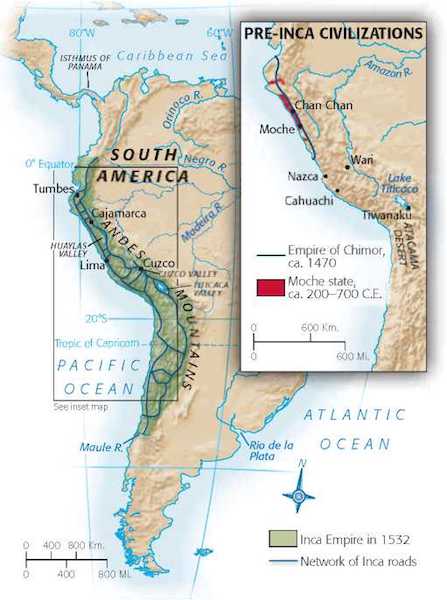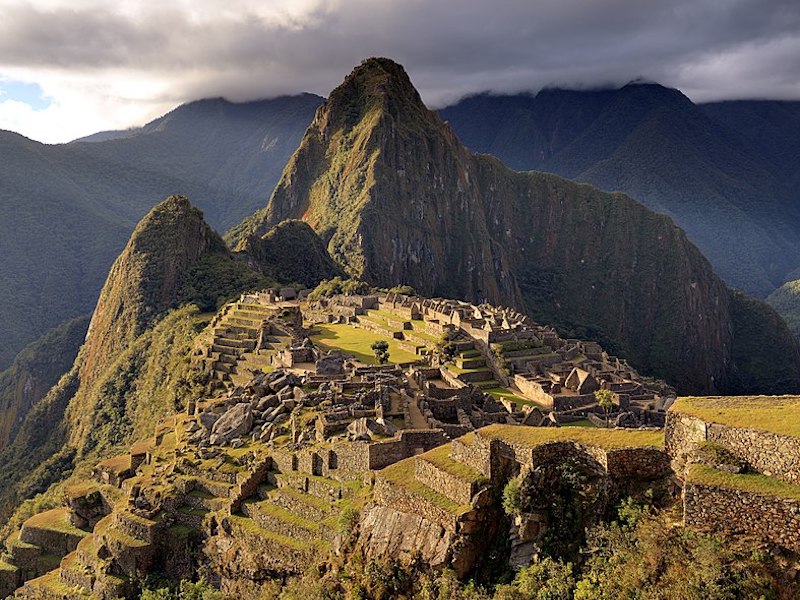Andean Civilizations
Episode #10 of the course Human history and the first civilizations by Brian Fagan
Hello!
Our final journey through the past takes us to South America. Here, major states flourished along the dry Peruvian coast and in the highland Andes. Their inhabitants adapted to a remarkable array of highland and lowland environments.
Origins
A series of chiefdoms developed along Peru’s north coast after 1800 BC, in one of the driest landscapes on earth. Settlements clustered along the coast with its rich anchovy fisheries. River valleys with fertile soils brought runoff water from the Andes mountains far inland.
Well-established trade routes connected different river valleys where people in small settlements grew cotton and other crops. They lived simple lives but their leaders built U-shaped ceremonial buildings.
Large scale irrigation agriculture led to more complex societies based on ceremonial centers like Sechin Alto in the Casma Valley near the coast. Sechin Alto’s mound was nearly 1,000 feet (300 m) long and formed the base of a U-shaped ceremonial center. By 1400 BC, there were several larger kingdoms that linked several valleys.
A major shrine of the highlands developed at Chavin de Huantar in the Andes foothills by 1200 BC. The ceremonial buildings were a maze of plazas, stairways, and galleries. The terraced temple stands 32 feet (10 m) high, a honeycomb of stone-lined passages and rooms. A carving of a jaguar-like human now named the Lanzon may have served as a ritual axis joining the heavens, the earth, and the underworld.
The Moche State
A major state known as the Moche arose on the coast by 200 BC, centered on the Chicama and Moche river valleys. Moche leaders presided over huge ceremonial centers and large-scale river irrigation works. We know of the leaders from spectacular, gold-adorned burials of lavishly adorned warrior priests, the elite of Moche society, found at Sipan in the Lambayeque valley.
The warrior priests ruled through family kin ties and presided over elaborate public ceremonies that included human sacrifice. Glittering with gold, they appeared in public on the adobe pyramids at huge ceremonial centers like Huaca del Sol and Huaca de la Luna near the modern city of Trujillo. Huaca del Sol stood 135 feet (41 m) above the river valley with a brightly painted temple complex at the summit.

Andean Civilizations, 200 – 1500 AD.
The Moche were expert metal workers in copper, gold, and silver, as well as accomplished potters, famous for their portrait vases of prominent people. Their state was a multi-valley civilization without writing that enjoyed an elaborate ritual life. But the Moche were vulnerable to major El Ninos, which decimated the anchovy fisheries and brought heavy rains and floods that wiped out valley irrigation systems. Moche society collapsed around AD 550.
Several smaller states emerged after Moche, among them Sican, famous for its lavish burials, then Chimor, which developed in AD 1375. Chimor’s lords dwelt in secluded compounds at Chan Chan, presiding over irrigation systems with canals that linked different valleys.
The Inca Empire
In AD 1475, ambitious Inca rulers from the Cuzco region high in the Andes conquered Chimor and made it part of their vast empire that extended from the highlands of modern-day northern Bolivia to Ecuador on the coast.
Inca civilization developed from earlier, increasingly elaborate kingdoms such as Tiwanaku on Lake Titicaca, which traded extensively with the coast. When Tiwanaku collapsed after AD 1200, Inca leaders created an expanding state in the 14th century that rapidly became an empire created through conquest.
The Inca were efficient soldiers and administrators. Their empire, based on Cuzco, was called Tawantinsuyu, “The Land of the Four Quarters,” as it was divided into four large provinces. The rulers created an elaborate road system that linked highlands and lowlands, developed a tax system using quipus, their knotted strings equivalent to writing, and closely controlled terrace hillside agriculture and lowland irrigation, as well as extensive trade networks.

The Machu Picchu, a UNESCO World Heritage Site near Cusco, Peru.
For all their efficient administration, the Inca, who controlled six million people, were vulnerable. Their empire fell apart when Spanish conquistador Francisco Pizarro arrived in 1532.
With the collapse of the Inca empire, the last of the ancient world’s pre-industrial civilizations vanished. Our journey through the remoter human past from our origins to the early civilizations is complete. I hope you’ve enjoyed the adventure.
Good luck with your adventures in archeology!
Recommended books
The Inca and Their Ancestors by Michael Moseley
The Incas by Craig Morris and Adriana von Hagen
Share with friends
